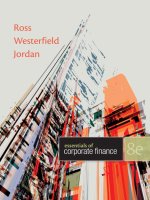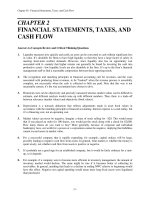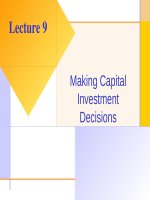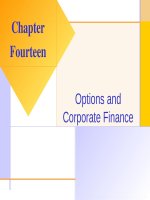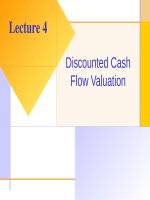Lecture Essentials of corporate finance (2/e) – Chap 2: Financial statements, taxes and cash flow
Bạn đang xem bản rút gọn của tài liệu. Xem và tải ngay bản đầy đủ của tài liệu tại đây (378.11 KB, 31 trang )
Financial statements, taxes
and cash flow
Chapter 2
Key concepts and skills
• Know the difference between book
value and market value
• Know the difference between
accounting income and cash flow
• Know the difference between average
and marginal tax rates
• Know how to determine a firm’s cash
flow from its financial statements
Copyright © 2011 McGraw-Hill Australia Pty Ltd
PPTs t/a Essentials of Corporate Finance 2e by Ross et al.
Slides prepared by David E. Allen and Abhay K. Singh
2-2
Chapter outline
• The balance sheet
• The income statement
• Taxes
• Cash flow
Copyright ©2011 McGraw-Hill Australia Pty Ltd
PPTs t/a Essentials of Corporate Finance 2e by Ross et al.
Slides prepared by David E. Allen and Abhay K. Singh
2-3
The balance sheet
• The balance sheet is a snapshot of a firm’s assets
and liabilities at a given point in time.
• Assets: The left-hand side:
− Current or fixed
− In order of decreasing liquidity
• Liabilities and owners’ equity: The right-hand side:
– Current or long term
– In ascending order of when due to be paid
• Balance sheet identity
Assets = Liabilities + Shareholders’
equity
Copyright ©2011
McGraw-Hill Australia Pty Ltd
PPTs t/a Essentials of Corporate Finance 2e by Ross et al.
Slides prepared by David E. Allen and Abhay K. Singh
2-4
The balance sheet (cont.)
Figure 2.1
Copyright ©2011 McGraw-Hill Australia Pty Ltd
PPTs t/a Essentials of Corporate Finance 2e by Ross et al.
Slides prepared by David E. Allen and Abhay K. Singh
2-5
The balance sheet (cont.)
• Net working capital
– Current assets minus current liabilities
– Usually positive for a healthy firm
• Liquidity
− Speed and ease of conversion to cash
without significant loss of value
− Valuable in avoiding financial distress
• Debt versus equity
− Shareholders’ equity = Assets - Liabilities
Copyright ©2011 McGraw-Hill Australia Pty Ltd
PPTs t/a Essentials of Corporate Finance 2e by Ross et al.
Slides prepared by David E. Allen and Abhay K. Singh
2-6
Oz Company balance sheet
Table 2.1
Visit au.finance.yahoo.com for more
financial statements and balance
sheets
Copyright ©2011 McGraw-Hill Australia Pty Ltd
PPTs t/a Essentials of Corporate Finance 2e by Ross et al.
Slides prepared by David E. Allen and Abhay K. Singh
2-7
Market value vs book value
• Market value is the price at which
assets, liabilities or equity can actually
be bought or sold.
• The balance sheet provides the book
value of assets, liabilities and equity.
• Market value and book value are often
very different. Why?
• Which is more important to the
decision-making process?
Copyright © 2011 McGraw-Hill Australia Pty Ltd
PPTs t/a Essentials of Corporate Finance 2e by Ross et al.
Slides prepared by David E. Allen and Abhay K. Singh
2-8
Battler Company
Example 2.2
Battler Company
Balance sheets
Book value versus market value
Book
Market
Assets
NWC
400
NFA
700
$1 100
Book
Market
Liabilities and Shareholders’
equity
600 LTD
1 000 SE
$1 600
Copyright ©2011 McGraw-Hill Australia Pty Ltd
PPTs t/a Essentials of Corporate Finance 2e by Ross et al.
Slides prepared by David E. Allen and Abhay K. Singh
500
500
600
1 100
$1 100
$1 600
2-9
The income statement
• The income statement measures performance over a
specified period of time (period, quarter, year).
• Report revenues first and then deduct any expenses
for the period.
• End result = Net income = ‘Bottom line’
– Dividends paid to shareholders
– Addition to retained earnings
• Income statement equation:
Net income = Revenue - Expenses
Copyright ©2011 McGraw-Hill Australia Pty Ltd
PPTs t/a Essentials of Corporate Finance 2e by Ross et al.
Slides prepared by David E. Allen and Abhay K. Singh
2-10
OZ Company income
statement
Table 2.2
Copyright © 2011 McGraw-Hill Australia Pty Ltd
PPTs t/a Essentials of Corporate Finance 2e by Ross et al.
Slides prepared by David E. Allen and Abhay K. Singh
2-11
The income statement
(cont.)
• AAS and the income statement
– The matching principle
• Recognise revenue when it is fully earned.
• Matching expenses required to generate
revenue to the period of recognition
• Non-cash items
– Expenses charged against revenue
that do not affect cash flow.
– Most important of these is
depreciation.
Copyright © 2011 McGraw-Hill Australia Pty Ltd
PPTs t/a Essentials of Corporate Finance 2e by Ross et al.
Slides prepared by David E. Allen and Abhay K. Singh
2-12
The income statement
(cont.)
• Time and costs
– Fixed or variable costs
– Not obvious on income statement
• Earnings management
– Smoothing earnings
– Wriggle room
Copyright © 2011 McGraw-Hill Australia Pty Ltd
PPTs t/a Essentials of Corporate Finance 2e by Ross et al.
Slides prepared by David E. Allen and Abhay K. Singh
2-13
Example: Work the Web
• Most Australian companies post their
annual reports on their websites. Look
for them in the investor or shareholder
areas.
• Go to companies’ websites and see
what kinds of financial reports you can
find.
• Example: Virgin Blue
Copyright ©2011 McGraw-Hill Australia Pty Ltd
PPTs t/a Essentials of Corporate Finance 2e by Ross et al.
Slides prepared by David E. Allen and Abhay K. Singh
2-14
Taxes
• The one thing we can rely on with taxes is that
they are always changing.
• Tax bill depends on tax code, which can be
amended by political will.
• Corporate tax in Australia and New Zealand
– Flat rate tax (currently 30%)
• Marginal vs average tax rates
– Marginal–the percentage paid on the next dollar
earned
– Average–the tax bill/taxable income
• Other taxes
Copyright ©2011 McGraw-Hill Australia Pty Ltd
PPTs t/a Essentials of Corporate Finance 2e by Ross et al.
Slides prepared by David E. Allen and Abhay K. Singh
2-15
Personal tax rates (2009/2010)
Table 2.3
Copyright ©2011 McGraw-Hill Australia Pty Ltd
PPTs t/a Essentials of Corporate Finance 2e by Ross et al.
Slides prepared by David E. Allen and Abhay K. Singh
2-16
Example: Marginal vs average
tax rates
• Bony Bushman has a taxable income
in Australia of $96 000.
– What is his tax bill?
– What is his average tax rate ?
– What is his marginal tax rate?
Copyright ©2011 McGraw-Hill Australia Pty Ltd
PPTs t/a Essentials of Corporate Finance 2e by Ross et al.
Slides prepared by David E. Allen and Abhay K. Singh
2-17
Example: Marginal vs average
tax rates
Personal tax rate
Taxable income
Rate
$0-6000
Nil
6001-35000
15%
35001-80000
30%
80001-180000
38%
18000145%
Total
Tax calculation
Taxable income Tax liability
6000
0
29000
4350
45000
13500
16000
6080
96000
Average tax
rate
Marginal tax rate
Copyright ©2011 McGraw-Hill Australia Pty Ltd
PPTs t/a Essentials of Corporate Finance 2e by Ross et al.
Slides prepared by David E. Allen and Abhay K. Singh
23930
24.9270833%
38%
2-18
Taxation of dividends:
An imputation system
• Major effect is that the double taxation of
company profits is negated.
• Company advises the shareholder of the
amount of company tax already paid on
the dividend.
• Shareholder then adds this amount of tax
to the cash dividend that they have
received and pays personal tax on the
grossed-up amount.
• Shareholder receives a tax (franking)
credit equivalent to the amount of tax paid
by the company.
Copyright ©2011 McGraw-Hill Australia Pty Ltd
PPTs t/a Essentials of Corporate Finance 2e by Ross et al.
Slides prepared by David E. Allen and Abhay K. Singh
2-19
Effect of a $700 dividend fully
franked at 30% tax rate—Example
2.5
Copyright © 2011 McGraw-Hill Australia Pty Ltd
PPTs t/a Essentials of Corporate Finance 2e by Ross et al.
Slides prepared by David E. Allen and Abhay K. Singh
2-20
Cash flow
• Cash flow is some of the most important information
that a financial manager can derive from financial
statements.
• The difference between the number of dollars that
come in and the number that go out.
• The statement of cash flows does not provide us with
the same information that we are looking at here.
• Cash flow identity
Cash flow from assets = Cash flow to creditors +
Cash flow to shareholders
Copyright © 2011 McGraw-Hill Australia Pty Ltd
PPTs t/a Essentials of Corporate Finance 2e by Ross et al.
Slides prepared by David E. Allen and Abhay K. Singh
2-21
Cash flow (cont.)
• Cash flow from assets = Operating cash flow –
Net capital spending – Changes in net working
capital.
• Operating cash flow
– Cash generated from a firm’s normal business
activities
• Capital spending
– Money spent on fixed assets less money received
from the sale of fixed assets
• Change in net working capital
– Net increase in current assets over current
liabilities
Copyright
©2011 McGraw-Hill Australia Pty Ltd
PPTs t/a Essentials of Corporate Finance 2e by Ross et al.
Slides prepared by David E. Allen and Abhay K. Singh
2-22
Cash flow (cont.)
• Free cash flow
– Different from cash flow from assets
– Cash that the firm is free to distribute to
creditors and shareholders because it is not
needed for working capital or fixed asset
investments
• Cash flow to creditors
– A firm’s interest payments to creditors less net
new borrowings
• Cash flow to shareholders
– Dividends paid out by a firm less net new
equity raised
Copyright ©2011 McGraw-Hill Australia Pty Ltd
PPTs t/a Essentials of Corporate Finance 2e by Ross et al.
Slides prepared by David E. Allen and Abhay K. Singh
2-23
OZ Company example
• OCF (I/S) = EBIT + Depreciation – Taxes =
$547
• NCS (B/S and I/S) = Ending net fixed assets –
Beginning net fixed assets + Depreciation =
$130
• Changes in NWC (B/S) = Ending NWC –
Beginning NWC = $330
• CFFA = 547 – 130 – 330 = $87
• CF to creditors (B/S and I/S) = Interest paid –
Net new borrowings = $24
• CF to stockholders (B/S and I/S) = Dividends
paid – Net new equity raised = $63
Copyright ©
2011
McGraw-Hill
Australia
Pty Ltd
• CFFA
=
24
+
63
=
$87
PPTs t/a Essentials of Corporate Finance 2e by Ross et al.
2-24
Slides prepared by David E. Allen and Abhay K. Singh
Cash flow summary
Table 2.5
Copyright ©2011 McGraw-Hill Australia Pty Ltd
PPTs t/a Essentials of Corporate Finance 2e by Ross et al.
Slides prepared by David E. Allen and Abhay K. Singh
2-25



